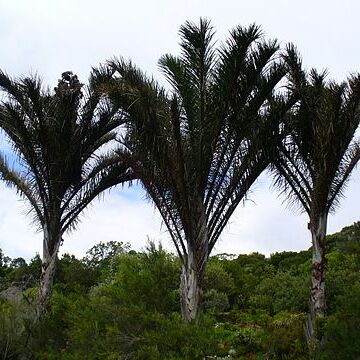A large unbranched stout tree up to 16 m tall. Stem up to 10 m tall, covered with the old persistent adpressed erect leafbases. Leaves rosulate, younger erect, outer somewhat spreading, pinnate, up to c. 10 m long; petiole unarmed concave and clasping below; the rhachis narrows into a canaliculate stalk for about two thirds of its length with the two spiny margins unequal in height gradually approaching one another until they merge (the lower ridge disappearing); at this point the leaf bends outwards; the pinnae are inserted on the outside of the marginal ridges, linear, 45-65 cm long, 5 cm broad, folded below, pale green above, waxy below, the margins bearing small sharp ascending pale spinules about 4 mm long, midrib raised with a double row of spinules in the lower half which merge to form a single row above. Inflorescence apical, erect, exserted centrally above the crown of leaves, conical, up to 3 m tall, its lowest flowering branches in the axils of the upper leaves; the subsequent leaves (c. 13) subtending the flowering branches, gradually reduced, the uppermost c. 50 cm long; peduncle 11 cm in diam. at the base, covered by 2-ranked, clasping imbricate tubular hard bracts; the basal bract of each branch differing from the following ones in shape; it is 2-pronged like a lobster-claw, flattened and bi-carinate, up to 40 cm long and 6 cm broad; it recurs on all the following side-branches becoming progressively smaller higher up; the subsequent bracts tubular with a truncate apex which forms an acute point, the points arranged alternately from side to side; branches exserted, laterally compressed, sub-4-ranked with 2 side-branches close together on each side of the rhachis, erect at first, patent in fruit, bracts similar to those covering the peduncle but reduced in size; the side branches bearing the numerous abbreviated fertile spikes in close proximity to one another; their arrangement is also sub-4-ranked with two rows of spikes close together on each side of the laterally compressed rhachis; fertile spikes spreading and twisting, with the unisexual flowers 2-ranked, the female occupying the lower part of the spike, the male the upper part; the apical spikes with male flowers only; the lower spikes up to 40 cm long becoming shorter towards the apex; fertile bracts similar in shape and form to those of the branches but smaller. Male flowers surrounded by a bi-carinate bracteole; hiding inside it is a small tubular, truncate calyx and exserted from it a corolla consisting of 3 hard linear-falcate segments which are nearly free to the base, 10 mm long, 2 mm broad, with a triangular, slightly swollen apex; stamens 6, free, filaments connivent, swollen, 4 mm long, 3-angled, apiculate, anthers with parallel linear locules 6 mm long. Female flowers surrounded by a bi-carinate bracteole and a second one inside it which is short, tubular and truncate, calyx and corolla enlarging after fruit has set, exserted from the bracteoles; calyx tubular, splitting irregularly into 3 truncate lobes when the ovary enlarges, 8 mm long; corolla segments 3, hard, beaked; staminodial ring adnate to the corolla, flattened, with unequal blunt teeth, some bearing minute anthers; ovary 3-celled, uni-ovulate, with the minute scales fimbriate; stigmas 3, sessile, apical, tongue-shaped, erect, at anthesis exposed through a small apical aperture of the corolla before the latter enlarges. Fruit one-seeded, ellipsoid, 6-9 cm long and 3-5 cm in diam. hard, shiny yellow-brown, shortly beaked, the reflexed convex scales arranged in 6 vertical rows, median groove shallow, edges with a short golden fringe of hairs.
More
A solitary palm. The stem is broad and 12 m tall. It has a dense crown. The leaves are stiffly erect and there are leaflets along the stalk. The leaf stalks do not have spines. The leaflets are narrow and they have spines along the edge. The flowering shoots is covered by a sheath 3 m long. The flowers are brownish. The fruit are oval and scaly. There is one seed.


